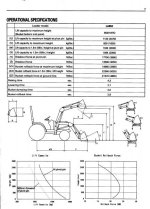</font><font color="blue" class="small">( I agree that is hard to picture a load that you start to lift that does not make it to full height. If the FEL is being used to lift something from a higher starting point, however, this might come into play.
I was using my FEL to lift an empty propane tank and the lift was done from the top by strap, so it began with the bucket near full lift height. It was a challenge. )</font>
Yep - SeymourBota nalied it! I also haven't had anything I couldn't lift from the ground to full height - but with some rocks, etc. I really didn't want to try!
I recently purchased an old Lincoln welder - she's a brute:
Bigger Pic
While I estimate that it weighs @ 600 lbs - and my LA352 FEL is rated at 925 lbs - I didn't think I'd have any problem lifting it - WRONG! /forums/images/graemlins/shocked.gif
The picture shows the welder on its back - when standing it's nearly 4' tall - so my bucket is raised fairly high to get a chain through its' top lifting eye and onto my bucket hooks.
Using just the FEL lift cylinders - I can *just* get it off the ground?!?! However, I have found if I leave some slack in my chain - I can easily lift it high enough for transporting with the "bucket curl" cylinders - it comes right up (and the FEL lift arms hold it up fine - they just can't raise it).
I too had puzzled previously about the various FEL lift ratings - but then this experience showed me clearly why there are differences: the *leverage* provided by the hydaulic FEL lifting cylinders changes (decreases) the higher the bucket goes.
********************
Maybe this example can help explain: have you ever worked out with free weights and done bicep curls?
When you are either at the end of a set - or trying to set a *personal best* with a heavy weight - it is difficult to get the weight started upwards from the bottom position where your arms are fully extended. This is because your bicep muscle doesn't have enough *leverage* yet to lift the weight.
But if you use *poor form* ( /forums/images/graemlins/wink.gif ) - and jerk the weight forward & up (using some combination of shoulders / hips etc.) a few inches - then the bicep has more leverage and you can finish the curl.
*****************
HA! I decided to search Google for "moment arm" - here's the first hit:
moment arm
Just imagine the diagram shown *upside down* - and the "bicep muscle" is a hydraulic cylinder of your FEL - except that the hydraulics *push* where the bicep *pulls* - mechanically, the FEL will have the same leverage limitation when lifting. Read the first paragraph - I think that sums it up nicely.
******************
Finally - in retrospect of my last 6 months or so of tractor ownership - I've had a couple *pucker-factor* moments - all of them, if I remember correctly - occurred when I was lifting something heavy - no real steep hilly areas here. I think I had the bucket raised up also - so I was lifting something from one of the chain hooks on the bucket.
It's all well and good that your FEL can lift something *a little* - it doesn't have to move far to get back to the ground. But once you raise something heavy up high - the forces keeping all four wheels on the ground can quickly get shifted WAAAYY out of whack!
This latest experience helped me realize that *when my FEL is struggling - take extra care & precautions*. In a way then - this inherent "leverage limitation" provides *built in safety* - so you can't put yourself into a dangerous situation too easily.
Happy lifting! /forums/images/graemlins/grin.gif
Dan

